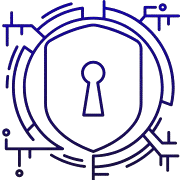Ethical hacking is an authorized testing practice where professionals use attacker-style methods to find weaknesses in systems and networks. The goal is simple: find flaws before real criminals do and help organizations strengthen security and protect sensitive information.
These authorized assessments include penetration tests, vulnerability scans, malware analysis, and risk management. Each activity mirrors real-world hacking techniques but runs with clear permission and a defined scope so no harm comes to users or data.
This guide is a practical, hands-on beginner’s program. You will learn the lifecycle of a pen test — reconnaissance, exploitation, reporting, and remediation — plus tools like Kali Linux, Metasploit, Nmap, and Wireshark.
By following these steps, readers in the United States can build job-ready skills for roles that protect network and information assets. Expect clear paths to certifications, reporting standards, and lawful disclosure practices.
Key Takeaways
- Authorized testing finds weaknesses before attackers do.
- Techniques mirror criminal methods but focus on improving security.
- Pen tests follow a clear lifecycle: recon, exploit, report, fix.
- Learning covers tools, certifications, and lawful practices.
- Strong programs protect data, information, and customer trust.
Ethical Hacking Basics: What It Is and Why It Matters Today
When security teams mirror real-world attacks under strict controls, they reveal hidden risks and strengthen defenses. This practice—commonly called ethical hacking—is authorized testing that helps organizations protect critical assets and sensitive information.
Definition, scope, and permission
Ethical hacking uses industry techniques to test networks and systems with explicit permission. Teams set scope, timelines, and allowed methods so tests remain safe and lawful.
Assessments avoid destructive actions and keep findings confidential. Results help management prioritize fixes and schedule remediation without disrupting operations.
The rising threat landscape
Cybercrime is growing fast: costs are projected to hit $13.82 trillion by 2028. In February 2024, the United States recorded an average data breach cost of $9.36 million.
These figures show why companies and government bodies invest in testing. Regular assessments reduce the chance of breaches, protect customer information and data, and improve overall security posture as threats evolve.
Ethical Hacking vs. Hacking: Key Differences in Intent, Methods, and Outcomes
Not all intrusions are equal: intent, method, and outcome separate legitimate testers from criminals.
White-hat, black-hat, and gray-hat roles
White-hat professionals—often called ethical hackers—work with permission. They follow scope, non-destructive tactics, and confidentiality to help companies fix gaps.
By contrast, malicious hackers break laws to steal data, keep secret access, or disrupt operations. They exploit accounts and exfiltrate sensitive information for profit or sabotage.
Gray-hat actors sit between these poles. They may reveal flaws without authorization and unintentionally aid attackers.
Goals, outcomes, and accountability
- Intent: testers reduce risk; criminals monetize or damage.
- Methods: similar tools, but authorized tests use guardrails like chain-of-custody.
- Outcomes: firms get remediation plans; attackers favor stealth and long-term access.
Authorization and accountability are the defining lines. Professional practice prevents liability, while illegal acts invite prosecution and reputational harm.
How Ethical Hacking Works: Services, Techniques, and Assessments
Specialized services translate attacker methods into controlled tests that show real risk to systems and data.
Services fall into clear categories. Penetration testing emulates intrusions to prove impact. Vulnerability assessments list and prioritize vulnerabilities without exploitation.
Malware analysis reverse-engineers samples to inform detections. Threat modeling maps assets, trust boundaries, and attacker paths so organizations can plan defenses.
Typical tools and outputs
Common tools include Nmap for scanning, Metasploit for controlled exploitation, Kali Linux as a platform, and Wireshark for packet inspection.
Assessments produce reports with severity ratings, proof-of-concept evidence, business impact narratives, and prioritized remediation steps. These deliverables help management approve fixes and align security with compliance needs.
- Define scope and testing goals with IT and management.
- Run scans and targeted tests using approved tools.
- Document exploited vulnerabilities, accessed assets, and detection gaps.
- Recommend fixes and schedule remediation with minimal production risk.
| Service | Main Goal | Action | Typical Deliverable |
|---|---|---|---|
| Penetration testing | Prove exploitability | Simulate attacks within scope | PoC, path-to-impact, remediation plan |
| Vulnerability assessment | Catalog weaknesses | Scan and prioritize findings | Inventory, severity ratings, patch guidance |
| Malware analysis | Understand threats | Reverse-engineer samples | IOC list, detection rules, mitigation steps |
| Threat modeling | Plan mitigations | Map assets and attack paths | Risk matrix, control recommendations |
Repeat assessments measure progress over time. Collaboration with security and IT teams ensures fixes match risk appetite and minimize downtime.
Confidentiality remains central: sensitive information found during services stays protected and is shared only with authorized stakeholders.
Inside a Pen Test: Phases, Social Engineering, and AI-Driven Enumeration
Penetration operations run in clear stages that show how an attacker can move from discovery to access. Reconnaissance builds the initial map using OSINT, Nmap port scans, and Wireshark traffic captures to profile the network footprint and viable entry points.

Recon and footprinting
OSINT targets personnel and technology. Scans reveal open ports and services. Traffic analysis exposes misconfigured devices and weak sessions.
AI-driven enumeration
AI correlates banners, leaked credentials, and misconfigurations at scale. This speeds discovery and guides focused testing with fewer false positives.
Exploitation and lateral movement
Exploitation techniques include SQL injection, XSS, and controlled denial-of-service as allowed by scope. Testers validate privilege escalation and lateral movement to map risk to critical systems.
Social engineering, documentation, and cleanup
Phishing, pretexting, and baiting simulations test user controls under strict approvals. Teams protect any accounts or tokens used, reset credentials, and document timestamps, commands, and payloads.
Operations finish by showing detection gaps, demonstrating evasion, and covering tracks so no artifacts remain. Final deliverables turn findings into prioritized hardening: patches, segmentation, baselines, and playbook updates to improve overall security.
Ethics and Legal Foundations for Ethical Hackers
Clear rules of engagement keep tests lawful and protect the organization from unintended harm.
Permission must be written and explicit. Agreements should list in-scope systems, testing windows, and permitted methods so teams operate within legal boundaries.
Getting explicit permission, defining scope, and avoiding harm
Non-destructive testing protects information and data. Testers avoid actions that risk downtime or loss of service.
Teams document timelines, rollback plans, and limits on pivoting. No exploitation beyond scope ensures compliance with federal and state laws in the United States.
Confidentiality, lawful methods, and responsible disclosure practices
Findings stay confidential. Logs, screenshots, and proofs-of-concept are shared only with authorized management and security contacts.
“Responsible disclosure balances timely fixes with shielding sensitive details until remediation is in place.”
Work aligns with legal and compliance teams. Government or regulated projects may need extra approvals and records.
- Follow the agreed rules: revoke temporary access after completion.
- Advise management: prioritize risks and plan safe remediation across systems.
- Review consent: update forms and methods to reduce harm and meet evolving standards.
Skills, Tools, and Certifications to Become a Certified Ethical Hacker
Start by building practical skills that link networking, systems, and scripting to real-world security tests. Focus on hands-on labs and short projects that show how attacks are discovered and fixed.
Core competencies include networking fundamentals, operating system internals, scripting and automation (Python, SQL), and security engineering practices that support reliable assessments.

Essential tools power daily work. Kali Linux provides a curated offensive toolkit. Nmap helps discovery and enumeration. Metasploit enables controlled exploitation. Wireshark gives packet-level visibility.
Certifications map to career stages. CEH and CompTIA PenTest+ teach foundational offensive skills. GPEN targets advanced testing. CISSP and CISM support leadership and governance roles. CompTIA Security+ covers core security concepts.
Structured programs and bootcamps accelerate learning. Examples include vendor certificates and short professional programs that bundle labs, reporting practice, and exam prep.
- Build a portfolio: labs, CTFs, and policy-aligned bug bounties with clear write-ups.
- Prepare interviews by explaining scope decisions, risk prioritization, and safe artifact handling.
- Keep skills current via threat feeds, OWASP guidance, and regular lab practice.
Career Outlook and Roles in Cybersecurity for Ethical Hackers
Demand for skilled defenders and testers has surged as companies hunt for talent that secures networks and protects data.
The U.S. Bureau of Labor Statistics projects a 33% rise in information security analyst roles from 2023 to 2033. Salaries reflect that demand: Glassdoor reports an average U.S. pay of $147,271 for an ethical hacker, though range varies by region, certifications, and experience.
Team operations: red, blue, and purple
Red teams simulate adversary campaigns across the kill chain to test detection and response under realistic pressure.
Blue teams focus on monitoring, network defense, data protection, and incident response that close gaps found during tests.
Purple teams merge offensive and defensive work to speed improvements and tighten operational feedback loops.
Where companies and government hire
Hiring spans finance, e-commerce, cloud and SaaS, media, data centers, and critical infrastructure. Both private firms and government agencies need talent for compliance, resilience, and incident readiness.
| Role | Main Focus | Typical Employer |
|---|---|---|
| Junior pentester | Vulnerability discovery, reporting | Consultancy, SaaS, finance |
| SOC analyst | Monitoring, triage, incident response | Enterprises, government, data centers |
| Security engineer | Hardening systems, automation | Cloud providers, e-commerce, media |
| Senior consultant / manager | Program design, governance, stakeholder communication | Companies, government agencies |
“Translate technical findings into business risk to secure resources and drive remediation.”
Build broad exposure across on-prem, cloud, and hybrid environments to strengthen network skills. Network in communities, maintain certifications, and practice clear communication to maximize future opportunities in this growing industry.
Conclusion
A structured testing program turns attacker methods into practical fixes that reduce real risk.
Permission-based, rules-driven tests like penetration testing, vulnerability assessments, and malware analysis translate findings into prioritized action. That process helps teams close the most dangerous vulnerabilities first.
Build a foundation in networking, operating systems, scripting, and hands-on labs. Pair learning with recognized certification milestones and a portfolio of practical work to show results.
Choose focused program options and keep skills current with tools and community mentorship. Always secure consent, protect information and data, and report responsibly to the organization.
In short, ethical hacking strengthens defenses by anticipating attacker moves and helping teams fix what matters most.
FAQ
What is ethical hacking and how can I start learning it?
Ethical hacking is the authorized testing of systems to find and fix vulnerabilities before attackers exploit them. Begin with a solid foundation in networking and operating systems, learn a scripting language like Python, practice on legal labs such as Hack The Box or TryHackMe, and study for entry certifications like CompTIA Security+ and CEH or CompTIA PenTest+ to validate skills.
How does authorized testing differ from illegal intrusion?
Authorized testing requires written permission, a defined scope, and clear rules of engagement. Illegal intrusion lacks consent and aims to steal data or disrupt systems. Professionals follow legal and contractual boundaries, document all actions, and avoid techniques that could cause harm to production environments.
Why does this type of security work matter today?
Cybercrime costs continue to rise and breaches affect U.S. businesses across sectors. Proactive testing helps organizations reduce risk, protect sensitive information, and meet regulatory and compliance requirements, saving money and reputation in the long run.
What’s the difference between a penetration test and a vulnerability assessment?
A vulnerability assessment identifies and catalogs weaknesses using automated scans and prioritization. A penetration test attempts to exploit selected weaknesses to demonstrate real-world impact. Both support remediation but pen tests show feasible attack paths and business risk more clearly.
What techniques are commonly used during a penetration test?
Typical techniques include reconnaissance and footprinting using OSINT, network scanning with Nmap, traffic analysis via Wireshark, exploitation such as SQL injection or cross-site scripting, lateral movement, and social engineering simulations that mirror real attack strategies.
How should findings be reported and remediated to management?
Reports must be clear, prioritized, and actionable. Include executive summaries, risk ratings, technical details, and step-by-step remediation recommendations. Translate technical impact into business risk to secure management buy-in and track fixes through remediation workflows.
What legal and ethical rules must testers follow?
Testers must obtain explicit written permission, define scope and timing, avoid methods that cause damage, and follow responsible disclosure practices. Confidentiality and adherence to laws, contracts, and organizational policies are mandatory to protect clients and testers alike.
What core skills and tools should aspiring testers learn?
Core skills include networking, system administration, scripting, and security engineering. Common tools are Kali Linux, Metasploit, Nmap, and Wireshark. Hands-on labs and structured training help build competence for real assessments.
Which certifications and education paths are most valuable?
Widely recognized credentials include CEH, CompTIA PenTest+, GPEN, CISSP, CISM, and Security+. Candidates also benefit from degrees in computer science or information security, bootcamps, and continual hands-on practice to stay current.
What career roles and teams hire these professionals?
Roles include penetration tester, red team operator, security consultant, and information security analyst. Organizations across finance, e-commerce, cloud and SaaS providers, and critical infrastructure hire testers. Teams may operate as red, blue, or purple teams within companies or for government agencies.
How does AI affect reconnaissance and enumeration?
AI accelerates data analysis for reconnaissance, helps prioritize targets, and automates enumeration workflows. Testers must use AI responsibly, ensuring outputs are validated and aligned with authorization and scope to avoid erroneous actions.
Can smaller companies benefit from pen testing and security assessments?
Yes. Small and medium businesses often lack mature defenses and can greatly reduce breach risk by investing in assessments, prioritized remediation, and employee training. Outsourced services and managed security providers can make testing affordable and practical.

